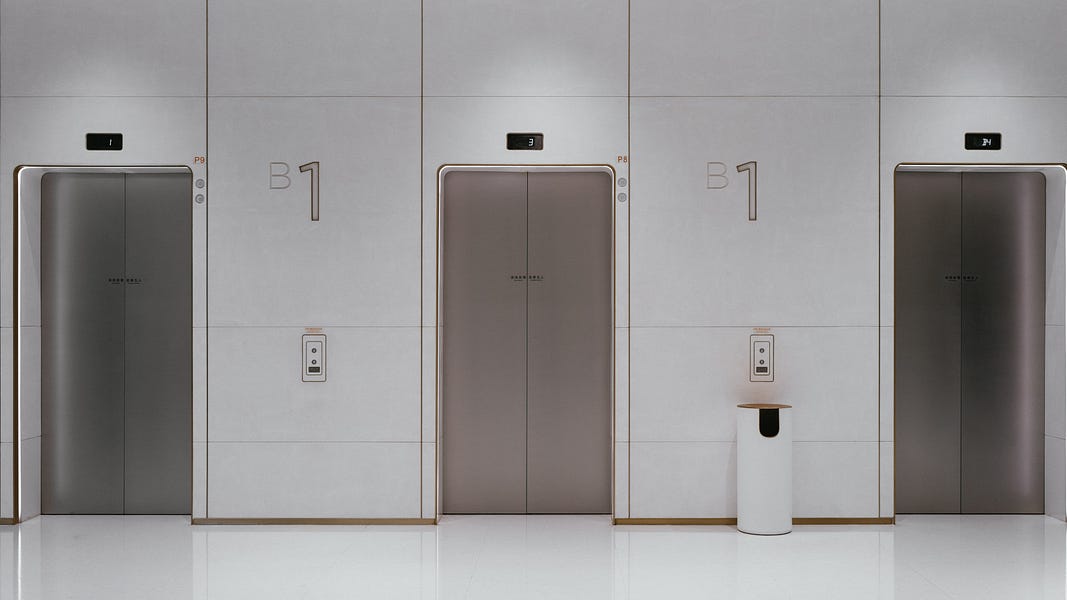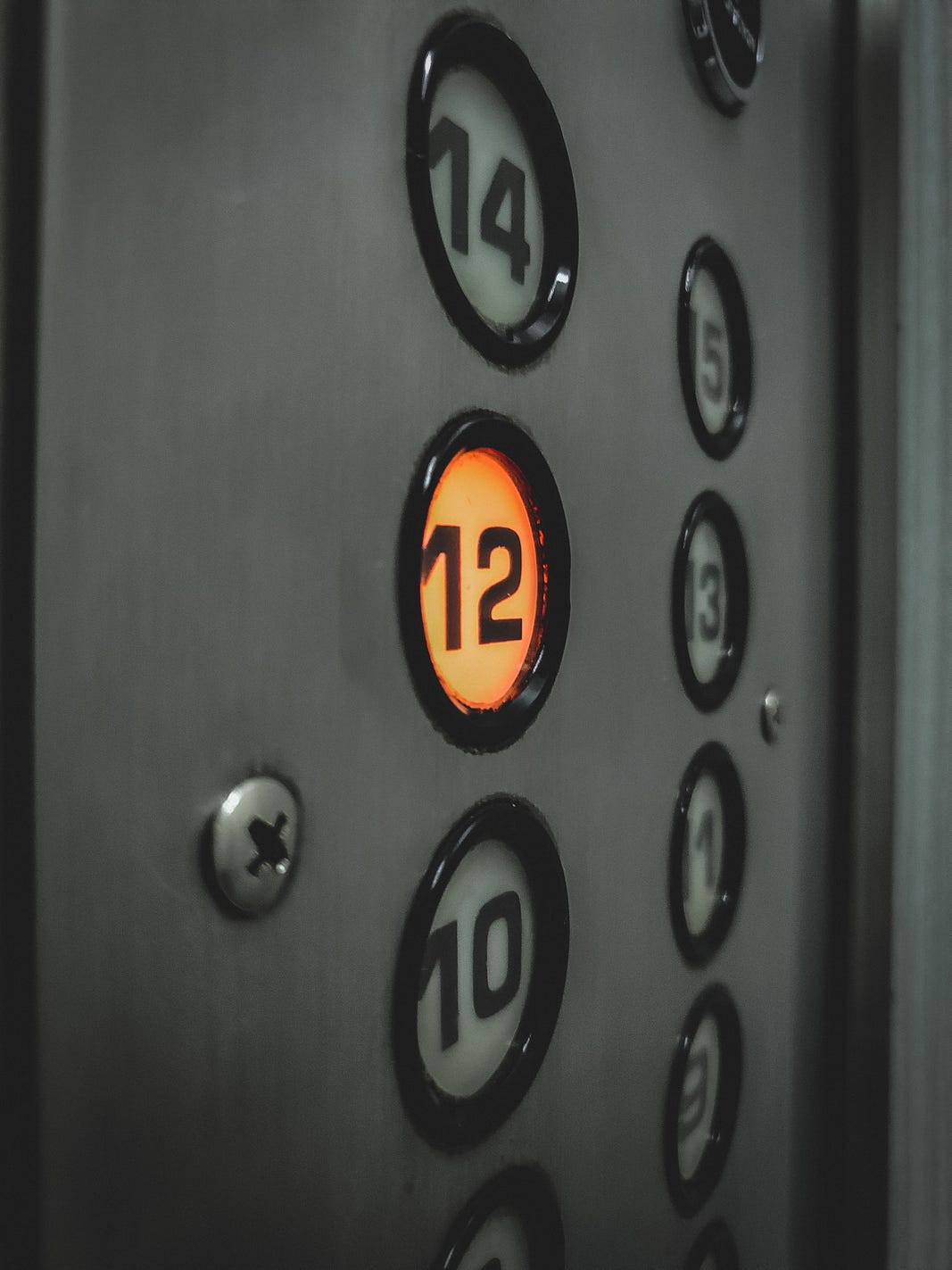
A bank of elevators in the lobby of a skyscraper. Photo by Edwin Chen on Unsplash
It happens all the time. You’re walking along, getting stuff done, and an elevator comes into the equation. Now what?

One kind of elevator call button. Any single call button means that you are either at the top or bottom floor. Photo by Ashwini Chaudhary(Monty) on Unsplash
- First, breathe. In through the nose, out through the mouth so you focus on doing that instead of thinking. Slow and measured. If your heart is beating fast, breathe deeper than usual, and feel your heart calm. Practice after you exert yourself so you can do it whenever you feel the need.
- If the Call Button is not active, touch it. Do not stand in front of the doors. Triage any other people waiting for an elevator, putting those with fewer mobility options to the front. Don’t be afraid to speak in order to facilitate passenger selection with strangers. It’s highly unlikely that anyone will assault you for this, but remain prepared, just in case.
- When a car arrives at your floor you will hear a bell or electronic chime and a light will appear next to the arriving car. On the ground floor, all cars go up. On the top floor, all cars go down. Any floors between will have both UP and DOWN arrows. One will be lit to indicate which direction the car is heading when a car is at a floor. So, if you want to leave the 11th floor and go to the ground floor of building with fifteen floors, you’d wait for a car to arrive with the DOWN indicator lit. †
- When the doors open, quickly scan the car for any disembarking passengers. If people are exiting, stand aside and allow them safe passage. Your turn will come. If the car is empty and no one else is waiting, feel free to enter.
- After entering the car locate the button panel and select your floor. The panel can be on either side of the doors, or even both. If you are closest to the panel it is customary to ask any other riders which floor they require and then pressing it for them. If nobody performs this role, floor selection is open to all. Step forward and commit.
- Selecting where you will stand depends on how many people are in the car and where you were in the queue to enter. For large loads move to the rear and turn to face the doors. Adjust your position to accommodate any other passengers. In the US, it is highly unusual to engage in social interactions while transiting floors. It is, however, acceptable to make subtle, all-ages jokes to lighten the mood. Do not expect effusive reactions or long conversations.
- Once the doors close and the car is in motion it will move to each selected floor in numerical order, opening and closing the doors to allow people to embark or exit. Try to position yourself in the car with respect to your selected floor. For example, if you are on the 14th floor and other passengers are getting off on lower floors, you can move to the back. This allows others to have more room to maneuver as they engage in the same organizational dance.
- When you reach your floor, disembark.
 Photo by Gaurav Baya on Unsplash
Photo by Gaurav Baya on UnsplashThis may seem like a lot, but there’s no need to worry. The basic rules of operation are easy to get the hang of as long as you practice good elevator etiquette every time you use one. In no time, you’ll get the hang of it.
Additional Notes
Now, for some tips & tricks to help smooth things out. Don’t worry if you don’t get to use them every time, but these could help make your time in an elevator more pleasurable.
There are a few buttons in an elevator that perform functions that are not tasked with taking passengers to a floor. Two of the most common are the OPEN and CLOSE buttons and pushing one will cause the doors to behave as instructed. Just be aware that many elevators won’t let you press the OPEN button past a set period of time, after which a buzzer will start to sound a mild alarm as an encouragement to allow the elevator to continue performing its job.
NOTE: The OPEN and CLOSE buttons are often depicted as glyphs. The OPEN button looks something like this: [<|>] and the CLOSE button something like this: [>|<].
PROTIP: If you need to keep the door open longer and don’t want the buzzer to admonish you, look for a control labeled HOLD. If there is none, that elevator doesn’t offer the feature. It could be a button or a toggle. You will find this control most commonly in Service Elevators.††
Did you know that elevator doors know when something or someone will block them from closing? How, you ask? There is a row of lights and light detectors inside the doors on one side, and mirrors inside the other. When any beam of light is broken, the doors stay open! Quite neat, but you can also exploit this. Place your arm across the edge of the door and you will hold it open for other passengers to enter or leave the car.
In The Unlikely Event of a Stuck Elevator…
Should nobody in the car have a mobile phone or cannot get a signal, most, if not all, elevators have either a phone or an intercom you can use to contact assistance should your elevator car stop moving at an inconvenient time, such as between floors.

In the immortal words of Douglas Adams, “Don’t panic.”
First of all, elevators are generally not air-tight, so you won’t run out of air anytime soon. Secondly, use a phone so someone knows where you are. Lastly, stay calm and wait patiently. At most, you’ll have a harrowing tale to tell at dinner.
In Conclusion
Run through the basics until you get them down. After a few trips on elevators using these methods you’ll get into the swing of things. Here’s a quick break-down to memorize, but after a while this will all become second nature:
- Press any inactive CALL button
- Let anyone already on the elevator out before boarding
- Let those less able to board the car before you
- Hold the door for others as needed
- Be polite
- Get on with your day
And that’s it! Great work and enjoy your elevator rides from now on!!
† A car that has been traveling up but has no more calls on higher floors can, after closing the doors, change directions. The doors will then re-open. This works even if you’ve already entered the elevator. You’ll just have to wait for the doors to cycle before you continue.
†† Service Elevators are a special variety of elevator designed to move goods and whatnot to other floors. They are generally far more utilitarian in design so that rough furniture handling doesn’t damage trim pieces or break mirrors.